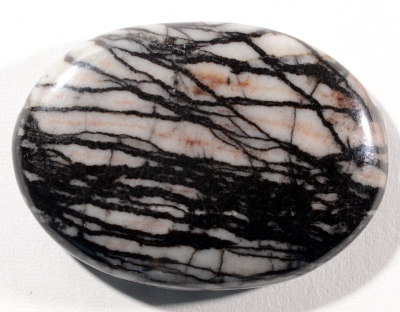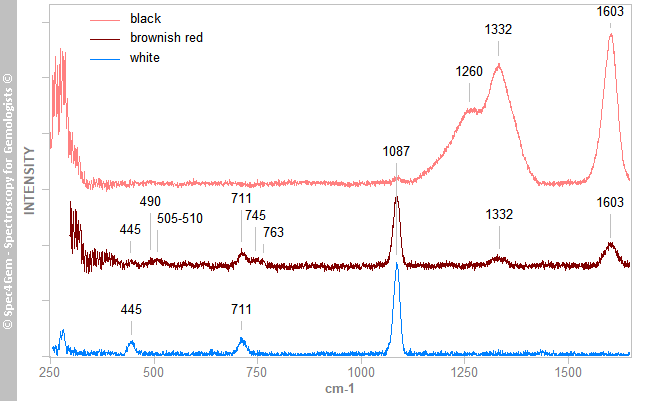Spiderweb 'jasper' - another black and white marble
- Details
- Created: Wednesday, 17 July 2024 11:27
The black and white spiderweb cabochon (Figure 1) represents a gemstone material which is available as cabochons, tumbled stones or even free-form ornamental gemstones.
Compared to other jaspers, with its spiderweb pattern, it stands out from the crowd although its luster is just greasy. At the time of writting, such material is reported to be extracted in Mexico but some other sources are also known in southern USA. The specific gravity of this cabochon is 2.56 and is in the range for jaspers (2.50 - 2.92). As this is a rock, the SG is just an indication. Although its trade name is spiderweb jasper, nothing in its classical gemological properties proves it is jasper which is a siliceous gemstone related to microgranular quartz and/or polycrystalline chalcedony. Because of the technical configurations, Raman spectroscopy, with its sub-millimetric collection spot size, is the best in this case compared to FTIR reflectance spectroscopy that has a much larger collection spot size with the available equipment.
 Figure 1. The 32.70 ct black and white spiderweb cabochon,
Figure 1. The 32.70 ct black and white spiderweb cabochon,misnamed spideweb jasper in the trade, is a kind of marble,
alternating black and white calcitic marbles, the black one colored
by carbonated coumpounds.
| Shape | oval cabochon |
| Size | 31.6 x 22.6 x 5.5 mm |
| Color | black, white to light gray and some brownish red traces |
| Diaphaneity | opaque |
| Lustre | greasy |
| Weight | 32.70 ct |
| SG | 2.56 |
| RI | no reading at the optical refractometer |
| DR | - |
| Pleochroism | - |
| Polariscope / Conoscope | - |
| SWUV | inert |
| LWUV | inert |
| Magnetic susceptibility N52 | very slightly attracted |
| Chelsea filter | inert |
Table 1. Observational and measured properties
Raman spectroscopy:
Raman spectra (Figure 2) were collected from three distinct spots, the first one in the white material of the cabochon (blue spectrum), the second one in the black material (red spectrum) and the last one in the brownish red material area (brownish red spectrum) which is finely grained and more difficult to collect. White material spectrum shows calcite's characteristics Raman peaks at 711 and 1087 cm-1. The black material spectrum is dominated by carbon (or carbonated compounds) revealed by the typical Raman peaks at 1332 and 1603 cm-1, respectively known as the Disordered and Graphitic bands (Brolly et al. 2015[1]), it contains also calcite as indicated by the 1087 cm-1 peak. The brownish red spectrum shows the same peaks as the white and black materials (calcite and carbon) and some weak peaks at 490, 505-510, 745 and 763 cm-1 that are indicative of the plagioclases. The presence of plagioclases is to be confirmed with better Raman spectra. The white material shows an addtional peak at 445 cm-1 which is not pertaining to calcite. This peak is also found in the brownish red material spectrum, likely due to the spectrum which is a combined spectrum of both materials because it is almost impossible to isolate the brownish red material from the white one with the acquiring setup. At the time of writting, this peak 445 cm-1 is not identified yet and it has to be worked out!
 Figure 2. Raman spectra of the white material (blue spectrum), the black material (red spectrum) and the brownish red material (brownish red spectrum), all indicate the main material is calcite (a calcitic marble).
Figure 2. Raman spectra of the white material (blue spectrum), the black material (red spectrum) and the brownish red material (brownish red spectrum), all indicate the main material is calcite (a calcitic marble).Conclusion:
This 32.70 ct black and white spiderweb cabochon is definitely a calcitic marble as shown by Raman spectroscopy and not a jasper. Its black color results of the presence of carbon or carbonated compounds.

